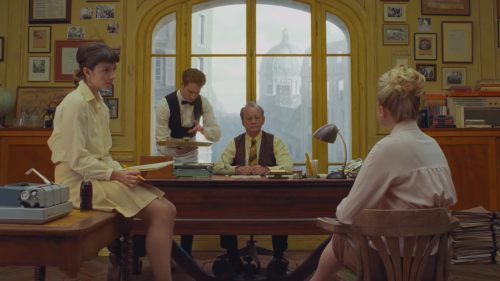RUSHMORE And The Style And Substance Of Wes Anderson
Rushmore is the best film Wes Anderson has ever made, and it would take something incredibly special for him to top it. Not because the filmmaker has less talent now than he did 15 years ago, but because the Anderson that made Rushmore has, more or less, disappeared.
The movie tells the story of ambitious, eccentric, insecure 15-year-old Max Fisher, a kid at a prep school who spends way too much time on extra-curricular activities, not enough time on his studies and is always trying to make his mark on his beloved Rushmore Academy.
Right from the start of Rushmore I still get that jolt that I’m watching something special. It’s such an original, efficient, beautiful, sad, hilarious work. Anderson is completely confident in his ability not just with his eyes, but also with his heart.
Before I talk about that film, though, it’s important to look at the film in the context of Anderson’s career. As it stands now his fans unofficially divide his films into two categories: The first consists of his first three films (Bottle Rocket, Rushmore and The Royal Tenenbaums). The second includes everything he’s made since. His first three films can easily be described as his most universally loved while his later efforts like The Life Aquatic With Steve Zissou and Moonrise Kingdom are met with a more mixed reaction. That’s not to say that they don’t have their defenders, but the number of them is much smaller. I still attest that The Darjeeling Limited and Fantastic Mr. Fox rival his best work, but I do concede that there’s still some magical, unexplainable element missing. Some have argued that Anderson’s films post-Tenenbaum lack a powerful emotional element, but I don’t buy that. Instead I think the emotions are there, but they are somewhat sacrificed to what has become a slightly bloated visual style.
Anderson’s films have these very easily noticeable qualities: a distinctive, detail-focused visual style and an equally discernible comedic dryness and emotional subtlety. You know a Wes Anderson movie from the first frame. That’s what makes him so special and that’s why even his lesser efforts are still pretty great.
His later films have a larger scope and budget that gave him the freedom to experiment, but that freedom also causes him to lose focus on his characters. The LIfe Aquatic is a funhouse of visual gags and really bonkers characters (especially Willem Dafoe’s Klaus), which makes it very entertaining. But the film’s core emotional story between Zissou (Bill Murray) and his possible son (Owen Wilson) doesn’t have the emotional pull it should. By the end we’re supposed to feel for this relationship, but the film becomes so muddied in its own gleeful imagery and imagination that we don’t. Moonrise Kingdom falls prey to the same problem. For me, The Darjeeling Limited and Fantastic Mr. Fox find Anderson moving back in the right direction, and the more I watch Fox the better it gets, but, for me, they don’t reach the height of his early career trifecta.
There’s no denying that for the first part of his career he found a beautiful balance with his unique visual and emotional styles. You can see as he evolved with Bottle Rocket, Rushmore and Tenenbaums his visual style slowly took a larger and larger place in his films.Bottle Rocket’s minimal budget (it’s claimed to be $7 million, but I just don’t believe it) made him disciplined visually. We still have the yellow jumpsuits and the great fireworks montage, but the film feels beautifully minimalist and Anderson leans heavily on his great comedic instincts (“Is that tape on your nose?” “Exactly.”), deft emotional touches and unique characters to make the film so memorable.
Two films later with The Royal Tenenbaums, Anderson had a much larger budget ($21 million) and an ensemble cast that included the likes of Gene Hackman, Anjelica Huston, Gwyneth Paltrow and Ben Stiller. There’s absolutely nothing minimalist about this movie. It’s big and bold, but it still maintains the strong emotional resonance of his early works. When Stiller’s Chas, an energetic ball of rage, finally concedes his love for his father it’s a beautiful moment because we care so much. The film’s third act is littered with one emotional payoff after another. It’s one of Anderson’s true masterpieces, but it is now obvious, looking at its ambitious visual sense, this was the film that began Anderson’s move into, for lack of a better phrase, style over substance.
In between Bottle Rocket and Tenenbaums, though, Anderson made Rushmore, a film that announced to the world that he was indeed a first-rate filmmaker. It’s also remains the pinnacle of his already decorated career.
The two main characters in Rushmore are Max Fisher (Jason Schwartzman) and Herman Blume (Bill Murray). While one is a teenager at a prep school and the other a 50-something, self-made millionaire the two men share many of the same qualities. For starters they’re both secretly lonely and inherently immature. So, of course, they instantly form a friendship.
It’s only fitting that they both fall for the same woman, Rosemary Cross, a first-grade teacher at Rushmore. It’s obvious she’s too old for Max and too mature for Herman, but the two men fight for her love even if it costs them their newfound friendship.
Just going over the bare bones of the film’s plot reveals that it’s a screwball comedy underlined with sadness. This is perfect for Anderson, who always seems to sneakily go for big laughs. And Murray’s brilliant delivery only makes things easier. Like when he stares sadly at his wrestling twin boys and admits, “Never in my wildest dreams did I ever think I’d have sons like these.” Anderson also uses Murray in brilliant and simple physical bits like his embarrassing attempt to spy on Rosemary by hiding behind a tree, getting caught and then trying to play it cool. And Schwartzman just kills it as Max in all his insecure and arrogant glory. He makes the now infamous exchange of “These are O.R. Scrubs.” “Oh, are they?” one of the film’s centerpieces. Rushmore is laced throughout with jokey comedic moments like these and they work because Anderson, and co-writer Owen Wilson, are just being genuine to their characters. If you make childish characters you should have them doing childish things. In fact the war of pranks that comes out of Max and Blume’s rivalry over Rosemary, which includes Blume driving over Max’s bike and Max getting him back by putting bees in the man’s hotel room, could be in a comedy for kids. This film is so zany when you think about it that it’s amazing how emotional things get.
As much as the comedy in the film is great, and RUSHMORE is, first and foremost, a comedy, it’s the meticulous and subtle scenes of pathos that make this Anderson’s true masterwork.
If you watch Rushmore closely you understand that a line of dialogue, a look, a shift of a hand can tell you everything about what’s going on inside a character. The film is filled with so many important small moments that when it’s over it feels like you’ve gone through a journey that could not have been squeezed into a breezy 93 minutes.
In fact the main emotional conflict in the film, Max dealing with the death of his mother, is only mentioned about a handful of times. But it’s the key to who Max is. He’s a busybody because he doesn’t want to spend time at home missing his mother. He’s dismissive of his father sometimes because that’s the only link he still has to her. He loves Rushmore because it was his mother’s idea he go there. Anderson never dwells on any of this, but instead allows Max’s actions to reflect these feelings.
And the visual style of Anderson is apparent throughout, but never feels overdone. There’s the breathtaking, French New Wave-inspired montage of Max’s numerous after-school groups and clubs (my personal favorite being “The Bombardment Society”). Also Murray’s The Graduate-esque cannonball-turned-underwater-solace scene comes to mind as well as the continuing theater curtain that covers the screen whenever the film story moves to a new month.
By the end, the world that Anderson creates and the characters than inhabit it come to a massively satisfying conclusion as Max premieres his latest Vietnam-set play. It’s a beautiful collage of images and music and emotions that comes to a head when Max asks Rosemary, whom both he and Herman fail in wooing, to dance. He asks the DJ to play a certain song. We hear The Faces’ “Ooh La La” and are treated to one of Anderson’s signature slow-motion closing shots that he’s used throughout his entire career.
In general terms Rushmore is Anderson’s greatest achievement because it’s his perfect balance of style and substance. His visual eccentricity doesn’t overshadow his characters and the emotional resonance of the film and, in fact, accentuates it beautifully.
After his first three films the potential of what a Wes Anderson movie can be has been brought down by his need to make his film’s visual sensibility overshadow its story and characters, especially with The Life Aquatic and Moonrise Kingdom. They are all still pretty fantastic and some get close to finding that magic, but until he can strike that balance of style and substance that make his first three films, and Rushmore in particular, so loved, we’ll just have to keep revisiting his masterpiece.



